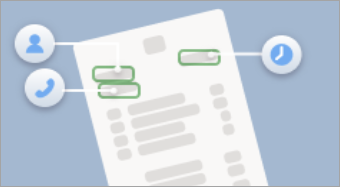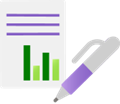Overview of Microsoft Syntex
Microsoft Syntex is a content understanding, processing, and compliance service that uses intelligent document processing, content artificial intelligence (AI), and advanced machine learning to automatically and thoughtfully find, organize, and classify documents in your SharePoint libraries, Microsoft Teams, OneDrive for Business, and Exchange.
With Syntex, you can automate your content-based processes—capturing the information in your business documents and transforming that information into working knowledge for your organization. Rather than clicking and sorting through hundreds or thousands of files, Syntex extracts, analyzes, and categorizes the data for you.
You can dive deeper into your content to truly understand it, and you can turn the information into meaningful insights that your organization can use to make informed business decisions.
Scenarios and use cases

Syntex can help your organization automate business processes, improve search accuracy, and manage compliance risk.
With content AI services and capabilities, you can build content understanding and classification directly into the content management flow.
Learn more about scenarios and use case for Microsoft Syntex.
Syntex services
Autofill columns

Autofill columns automatically extract, summarize, or generate content from files uploaded to a SharePoint document library. Using large language models (LLMs), designated columns can save metadata automatically, streamlining the process of managing files and their associated information.
Learn more about autofill columns in Microsoft Syntex.
Content assembly
Use content assembly to automatically generate standard repetitive business documents, such as contracts, statements of work, service agreements, letters of consent, and correspondence. You can do all these tasks quicker, more consistently, and with fewer errors in Syntex.

You create modern templates based on the business documents you use most. You then use those templates to automatically generate new documents using SharePoint lists or user entries as a data source.
Learn more about how to generate documents using content assembly.
Document processing
Prebuilt document processing

Use a prebuilt model to save time processing and extracting information from contracts, invoices, and receipts, and detecting and extracting sensitive information from documents. Prebuilt models are pretrained to recognize common business documents and the structured information in the documents.
Instead of having to create a new document processing model from scratch, you can use a prebuilt model to jumpstart your document project.
Learn more about prebuilt models in Microsoft Syntex.
Structured and freeform document processing

Use a structured model to automatically identify field and table values. It works best for structured or semi-structured documents, such as forms and invoices. Use a freeform model to automatically extract information from unstructured and freeform documents, such as letters and contracts where the information can appear anywhere in the document.
Both structured and freeform models use Microsoft Power Apps AI Builder to create and train models within Syntex.
Learn more about structured and freeform models in Microsoft Syntex.
Unstructured document processing

Use an unstructured model to automatically classify documents and extract information from them. It works best for documents that vary in composition, such as letters or contracts. This model type supports the widest range of file types.
Learn more about unstructured models in Microsoft Syntex.
Image tagging
Use image tagging in Syntex to find and manage images in SharePoint document libraries. Syntex automatically tags images with descriptive keywords using AI. These keywords are stored in a managed metadata column, making it easier to search, sort, filter, and manage the images.

Learn more about image tagging in Microsoft Syntex.
Taxonomy tagging

Use taxonomy tagging in Syntex to find and manage terms in SharePoint document libraries. Syntex automatically tags documents with terms or terms sets configured in your taxonomy store using AI. These terms are stored in a managed metadata column, making the documents easier to search, sort, filter, and manage.
Learn more about taxonomy tagging in Microsoft Syntex.
Document translation
Easily create a translated copy of a document or video transcipt in a SharePoint document library. You translate the file, while preserving the original format and structure of the file. Translation is available for all supported languages and dialects.

Learn more about translation in Microsoft Syntex.
SharePoint eSignature

Send electronic requests using SharePoint eSignature, keeping your content in Microsoft 365 while it’s being reviewed and signed. Use eSignature to quickly and securely send documents for signature to people both inside and outside of your organization.
Learn more about using SharePoint eSignature.
Optical character recognition
The optical character recognition (OCR) service in Syntex lets you extract printed or handwritten text from images. Syntex automatically scans the image files, extracts the relevant text, and makes the text from the images available for search and indexing. This lets you quickly and accurately find the keywords and phrases you're looking for.

Learn more about using the OCR service in Microsoft Syntex.
Autofill columns
Autofill columns automatically extract, summarize, or generate content from files uploaded to a SharePoint document library. By using large language models through generative AI, autofill columns can save metadata automatically, streamlining the process of managing files and their associated information.
Learn more about using autofill columns in Microsoft Syntex.
Microsoft 365 Archive

Microsoft 365 Archive is a cost-effective, long-term storage solution for inactive or historical data in SharePoint. Because the data is archived in place, the content retains Microsoft 365 security, compliance, search, and rich metadata.
Learn more about Microsoft 365 Archive (Preview).
Microsoft 365 Backup
Microsoft 365 Backup provides modern backup and recovery capabilities for SharePoint, Exchange Online, and OneDrive for Business, keeping the data all within the Microsoft 365 security boundary. With Microsoft 365 Backup, your organization knows that your content is securely and efficiently backed up and restorable within hours rather than months.

Learn more about Microsoft 365 Backup (Preview).
Other features
Annotations
Use the annotations feature in Syntex to add notes, comment, and collaborate with others on your content in document libraries. You can use annotations without modifying the original files, so the original records are preserved.
Learn more about using annotations in Microsoft Syntex.
Content query
The content query feature in Syntex lets you perform specific metadata-based queries on SharePoint document libraries. You can make faster, more precise queries based on specific metadata column values, rather than just searching for keywords.
Learn more about how to search for metadata in document libraries in Microsoft Syntex.
Merge and extract PDFs
Quickly combine multiple PDF files into a single PDF file, or split a larger PDF file into multiple smaller PDF files to better organize the information you want to view or share with others.
Learn more about merging and extracting PDF files in Microsoft Syntex.
Processing rules
Syntex lets you build simple rules-driven actions in document libraries based on metadata. From a document library, you can create rules to automate tasks such as sending a notification when metadata changes in a file, when a new file is created in the library, or when files are moved or copied based on metadata extracted by Syntex models.
Learn more about content processing rules in Microsoft Syntex.
Solution accelerators
SharePoint site templates for Microsoft Syntex are prebuilt, ready-to-deploy, and customizable. Use these templates to jumpstart a professional site to manage, process, and track the status of business documents in your organization.
Learn more about the contracts management and accounts payable accelerators.
Content compliance
Understanding your content allows for better compliance control and increases management and governance options for all your data. When content is properly tagged and labeled, you have better control over your data and can follow regulations more easily. Syntex helps you ensure compliance by using retention labels and sensitivity labels to manage your documents.
Learn more about how to apply retention labels and sensitivity labels to models in Microsoft Syntex.
Premium taxonomy features
Benefit from the following additional term store features for admins:
SKOS-based term set import, which lets you import a term set using a SKOS-based format.
Pushing enterprise content types to a hub site, which also adds them to the associated sites and any newly created lists or libraries.
Term store reports, which provides you with insights into published term sets and their use across your organization.